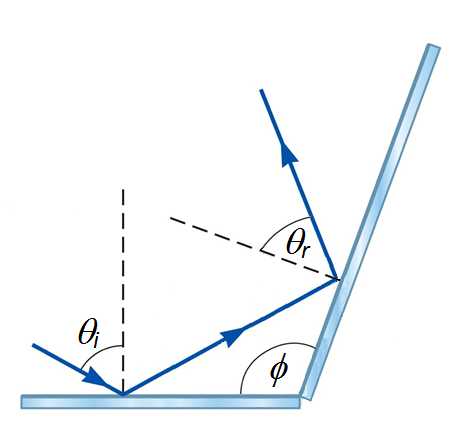
Taking this into account, we obtain the following matrix for a reflectionġ u x 2 + u y 2 . If u was not a unit vector to begin with, it of course suffices to divide by its magnitude before proceeding. Therefore the matrix of the transformation is To derive the matrix with respect to x, y coordinates, we resort to a trick: The principle is to have the blazed oblique reflection surface with the blaze angle such that the angle between the incident and the reflected light is equal to. mirroring describes a reflection at the x-axis which is included in the transformation prior to.

(In fact, this is the formula used in the to draw the diagram in this entry.) const double angle, Read accessor for the angle. Double refraction was first observed in 1669 by Erasmus Bartholin in experiments with Iceland spar crystal and elucidated in 1690 by Huygens. What is observed depends on the angle of the beam with respect to the entrant face. In the decomposition 𝐰 = a 𝐮 + b 𝐯, In double refraction, light enters a crystal the optical properties of which differ along two or more of the crystal axes. We will then need the so-called "addition formulas". We often need to deal with expressions in which two or more angles are involved, such as \displaystyle \sin(u+v). The addition, subtraction and double-angle formulas To avoid mistakes, we can check that this is true for several different values of \displaystyle v.Ĭheck: \displaystyle \ \cos 0 = \sin (0 + \pi / 2)=1. You can change the angle of intersecting lines by moving the Black Slider. Move the slider to change the angle of the intersecting lines. We can think of double refraction as the end which divides into two roads. It is an optical property in which a single ray of unpolarized light enters an anisotropic medium and splits into two rays, each travelling in a different direction. This can be done in several ways, but the most natural is to write \displaystyle \cos v = \sin (v + \pi / 2). Double Reflection over Intersecting Lines. The double refraction of light is the phenomenon of birefringence. For instance, if we want to express \displaystyle \cos v as the sine of an angle, we can shift the graph of \displaystyle \sin v along in the \displaystyle v direction, so that it coincides with the graph of \displaystyle \cos v. \displaystyle (\sin v)^2 + (\cos v)^2 = 1\,\mboxĪlternatively, we can derive these relationships by reflecting and/or shifting the graph of sine and cosine. The right-angled triangle on the right shows that This identity is the most basic, but is in fact nothing more than Pythagorean theorem, applied to the unit circle. There are many more than we can deal with in this course, but most can be derived from the so-called Pythagorean identity and the addition and subtraction formulas (see below), which are important to know by heart.
#Double angle of reflection how to#
Here we will give some of these trigonometric relationships, and show how to derive them. They are usually known as the trigonometric identities. reflecting these points through the x-axis, y-axis and origin, we obtain the. There are a variety of trigonometric formulas which relate the sine, cosine or tangent for an angle or multiples of an angle. 4.4 Power Reduction and Half Angle Formulas. Simplify trigonometric expressions with the help of trigonometric formulas.Derive trigonometric relationships from symmetries in the unit circle.

After this section, you will have learned how to: Alternatively you can recollect that sin(2x) 2 sin(x)cos(x), which is me answering the question you actually asked and should give you the double angle.


 0 kommentar(er)
0 kommentar(er)
